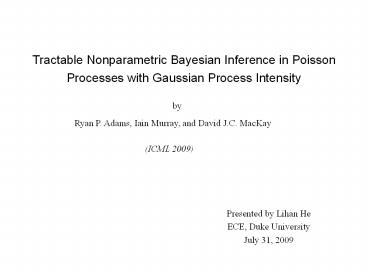Tractable Nonparametric Bayesian Inference in Poisson Processes with Gaussian Process Intensity - PowerPoint PPT Presentation
1 / 19
Title:
Tractable Nonparametric Bayesian Inference in Poisson Processes with Gaussian Process Intensity
Description:
Tractable Nonparametric Bayesian Inference in Poisson Processes with Gaussian ... for the Gaussian Cox process that avoids the intractability of such model; ... – PowerPoint PPT presentation
Number of Views:69
Avg rating:3.0/5.0
Title: Tractable Nonparametric Bayesian Inference in Poisson Processes with Gaussian Process Intensity
1
Tractable Nonparametric Bayesian Inference in
Poisson Processes with Gaussian Process Intensity
by
Ryan P. Adams, Iain Murray, and David J.C. MacKay
(ICML 2009)
Presented by Lihan He ECE, Duke University July
31, 2009
2
Outline
- Introduction
- The model
- Poisson distribution
- Poisson process
- Gaussian process
- Gaussian Cox process
- Generating data from Gaussian Cox process
- Inference by MCMC
- Experimental results
- Conclusion
2/19
3
Introduction
Inhomogeneous Poisson process
- A counting process
- Rate of arrivals varies in time or space
- Intensity function ?(s)
- Astronomy, forestry, birth model, etc.
3/19
4
Introduction
How to model the intensity function ?(s)
- Using Gaussian process
- Nonparametrical approach
- Called Gaussian Cox process
Difficulty intractable in inference
- Double-stochastic process
- Some approximation methods in previous research
- This paper tractable inference
- Introducing latent variables
- MCMC inference Metropolis-Hastings method
- No approximation
4/19
5
Model Poisson distribution
Discrete random variable X has p.m.f.
for k 0, 1, 2,
- Number of event arrivals
- Parameter ?
- EX ?
- Conjugate prior Gamma distribution
5/19
6
Model Poisson process
The Poisson process is parameterized by an
intensity function
such that the random number of event
within a subregion
is Poisson distributed with parameter
for k 0, 1, 2,
- N(0)0
- The number of events in disjoint subregions are
independent - No events happen simultaneously
- Likelihood function
6/19
7
Model Poisson process
Two-dimensional spatial Poisson process
One-dimensional temporal Poisson process
7/19
8
Model Gaussian Cox process
Using Gaussian process prior for intensity
function ?(s)
? upper bound on ?(s)
s logistic function
g(s) random scalar function, drawn from a
Gaussian process prior
8/19
9
Model Gaussian process
Definition Let g(g(x1), g(x2), , g(xN)) be an
N-dimensional vector of function values evaluated
at N points x1N. P(g) is a Gaussian process if
for any finite subset x1, , xN the marginal
distribution over that finite subset g has a
multivariate Gaussian distribution.
- Nonparametric prior (without parameterizing g, as
gwTx) - Infinite dimension prior (dimension N is
flexible), but only need to work with finite
dimensional problem - Fully specified by the mean function and
the covariance function
Mean function is usually defined to be zero
Example covariance function
9/19
10
Model Generating data from Gaussian Cox process
Objective generate a set of event skk1K on
some subregion T which are drawn from Poisson
process with intensity function
10/19
11
Inference
Given a set of K event skk1K on some
subregion T as observed data, what is the
posterior distribution over ?(s)?
Poisson process likelihood function
Posterior
11/19
12
Inference
Augment the posterior distribution by introducing
latent variables to make the MCMC-based inference
tractable.
Observed data
Introduced latent variables
- Total number of thinned events M
- Locations of thinned events
- Values of the function g(s) at the thinned events
- Values of the function g(s) at the observed events
Complete likelihood
12/19
13
Inference
MCMC inference sample
Sample M and
Metropolis-Hasting method
Metropolis-Hasting method draw a new sample
xt1based on the last sample xt and a proposal
distribution q(xxt)
- Sample x from proposal q(x xt)
2. Compute acceptance ratio
3. Sample rU(0,1)
4. If rlta, accept x as new sample, i.e.,
xt1x otherwise, reject x, let xt1xt.
13/19
14
Inference
Sample M Metropolis-Hasting method
Proposal distribution for inserting one thinned
event
Proposal distribution for deleting one thinned
event
Acceptance ratio for inserting one thinned event
Acceptance ratio for deleting one thinned event
14/19
15
Inference
Sample Metropolis-Hasting
method
Acceptance ratio for sampling a thinned event
Sample gMK Hamiltonian Monte Carlo method
(Duane et al, 1987)
Sample ? place Gamma prior on ?
Conjugate prior, the posterior can be derived
analytically.
15/19
16
Experimental results
Synthetic data
53 events
29 events
235 events
16/19
17
Experimental results
Coal mining disaster data
191 coal mine explosions in British from year
1875 to 1962
17/19
18
Experimental results
Redwoods data
195 redwood locations
18/19
19
Conclusion
- Proposed a novel method of inference for the
Gaussian Cox process that avoids the
intractability of such model - Using a generative prior that allows exact
Poisson data to be generated from a random
intensity function drawn from a transformed
Gaussian process - Using MCMC method to infer the posterior
distribution of the intensity function - Compared to other method, having better result
- Having significant computational demands
infeasible for data sets that have more than
several thousand event.
19/19































